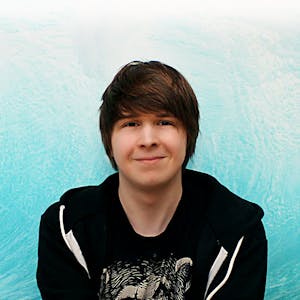That's our kind of our go-to seeded value. And now we have a little more variation. Usually for, um, a fire, you would not use ovals or circles, but you would use, um, like a texture with the lit of a smoky texture. So it has, so it's not so clear exactly like what the, um, the like delineation of that shape is, or like way more particles though, that you cannot even see like that individual with a much lower, let's see what happens. Let's do, let's do 10 times as many particles. And let's, um, 10th with one 10th of the alpha.
Okay. Now, of course it's going to go slow. It's going to go super slow. You know. So good day. Thank you. Thanks, James. I hope people are following along with how this works. There's, I covered a lot here. Um, so James, is there anything else with this fire that I should get into, or is this like a good enough start? That's brilliant. I really enjoyed that. That's really helpful. Thank you. Thank you so much. So there's other ways to do it, of course. Um, another way to do it, which I, I don't want to get too into right now, but that would be like using object oriented system. And that's how a lot of particle systems work. And the way that would work is you, um, you would create an object. Um, and like that object is the particle. It has a position, X and Y position. And it has like a, um, color at a time, a lifetime. And you can like, for, there's like thousands of those particles in the list and you are continually adding particles, you know, and all those particles you're moving up and slowly fading out and controlling in that way. And that, that actually is how most particle systems like work. Um, you only have a good example. Shade for that too. I'm going to be doing a talk about my little JS engine for, um, for this thing on like, uh, this weekend. I think I don't know the day exactly the seventh, I think, but one of the things that just added is this particle editor tool. I'm just barely started working with this, but this does, so under the hood, this does use a particle system and you're just given access to control like these, um, these different parameters, which are kind of like the minimal parameters you expect, such as like the start color, the end color. Um, it can, it can choose between a star color and start color B and color A and color B to get some variation. Uh, then you like it. Yeah, this is just, this is standard particle stuff. You're starting your end size, you know, your speed, your speed. Um, this is a little messed up. I have to work on this. I've noticed some issues with it since I've created it that caused it to be not for easier friendly. Um, but ultimately it gives you, it gives you an idea of how part of those systems like work, you know, and there's multiple ways to do it. If you wanted to do a fire that was completely static, not moving at all, you would probably do in a totally different way because this is all concern with motion. And if you're, if you're interested in like, um, non moving fire, that's a different thing. So also check out on Twitter because there's so many other ways to do fire. There's all these, um, simulation ways of doing it. There's tricky ways. Here's an, here's another one I did. This uses, you know, something similar to what I showed you guys, but I'm in the DWEET, I was not able to fit like the, um, the global composite operation, for example. So I could, I could grab this and throw it in here. Um, oh, no, I did, I did fit it in there. I used the screen one, which is, which is very similar to the, um, not the exact. I think screen is the same as lighter. Actually. No, it's not the same. It looks a little bit different. It looks a little bit different. I like later better. Honestly, but it doesn't fade out or anything like that. So that's, that's a good place to go to for ideas. Um, don't forget about the embers too. That's part of these tweaking effects often requires multiple effects layered on top. Yeah. And in this case, you've got to have the embers close to each other to create the, um, result. Because when you think about, even when you think about how fire works, there is two very distinct things going on. There's like the fire itself. And then there's this little embers that fly away. And they just don't really use it. And actually there's three things. Um, there's a smoke, there's a smoke too. So the smoke, it's not gonna look right. Um, yeah, I guess there are fires without smoke, but normally you want smoke and that is going to work differently. It will work similar in some ways, where you might have, you know, these circles that are fading in or out, but it's not going to use a lighter composite operation, like an additive blending. It's probably just going to be, um, dark black, kind of thing. Let's turn this into smoke really quick. Um, let's save fire. So let's get rid of my black fill. Let's get rid of my, um, rid of my hue. Let's get rid of my, um, hue saturation, maybe saturation value. I'm going to, I'll, I'll, um, that's not, doesn't even matter. Let's give it some value, a little variation of smoke there. Um, um, now smoke might look better if it didn't go tiny. At the top instead, like, um, more like faded out at the top, it got bigger, actually. And then faded out. You gotta think about how these things work. Um, it's a subtle difference, but when something starts big and goes small versus, you know, starts small, going big. Um, that will affect. So here we got with hey, that's our radius. So radius is one minus P. You can go something like that.











Comments